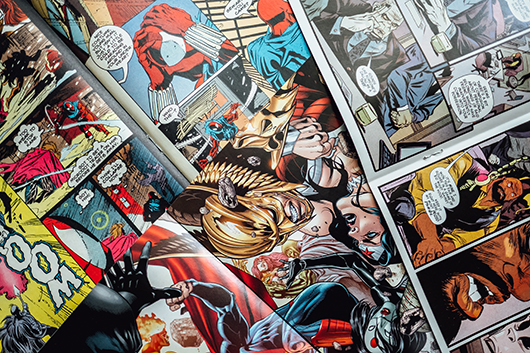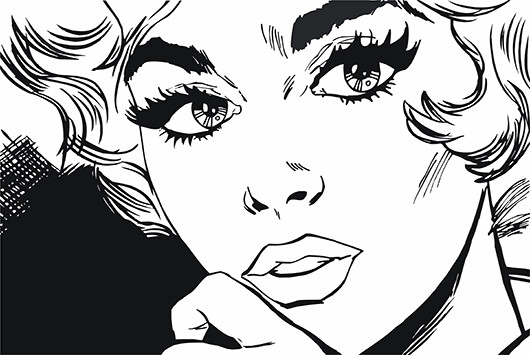Knowing the Rules of Comic Page Layouts
September 29, 2020
A superb comic book layout aims to help the reader logically organize the panels in their mind to tell the story.
If you have a poor comic page layout, then your readers’ eyes will become confused, and they will not be reading the comic in the manner that you would like them to, the way that makes the most sense to the story and the reader.
Comics come in many unique forms, from traditional newspaper comics to graphic novels to manga to online webcomics. Here are some tips and tricks from experts who create Japanese comics to Neil Cohn, an academic focusing on comic book page layouts’ rules.
A Brief History of the Comic Book
Many argue that visual storytelling has been around since the Stone Age when the first Neanderthal represented an experience through pictures.
Pictographs and hieroglyphics could be characterized as narratives presented in pictures and convey information – the basic definition of visual storytelling. European broadsheets in the 17th century and satirical magazines from the latter half of the 18th century introduced speech bubbles and other critical elements to the art form.
However, the comic book as it is today, either in book form or in panel form like in a newspaper, wasn’t developed until the very end of the 19th century. On May 5, 1895, Hogan’s Alley (by R.F. Outcault) appeared in the New York World, and comic books were born.
Soon humorous comics were a mainstay in every major newspaper across the United States. Comics readers clamored for more, and in 1933, Funnies on Parade came out, a collection of popular strips like the Katzenjammer Kids or Mutt & Jeff.
The landmark issue of Action Comics #1, featuring none other than the Man of Steel himself, Superman, came out in 1938. The rest, as they say, is history. Soon Batman, Wonder Woman, and the Human Torch were all gaining fans and popularity.
Comic book artists soon figured out that the form wasn’t limited to humor and began to expand comics into the fantasy and action genres. Magazines like Weird Science and The Vault of Horror broadened the stories that comic books could tell.
As comic books evolve, the way they look develops as well. Artists and writers regularly stretch the possible parameters in the world of comic books and graphic novels. One country that takes its comics very seriously in Japan.
The Popularity of Japanese Comics
Manga is the name of comics in Japan, and this art form confirms a style made prevalent in the late 19th century. In Japan, people of every age read manga, and the art form includes stories from all genres.
Manga is such a vital industry that in 1995, it was valued at 586.4 billion yen, or $6 billion. Because the Japanese written language and Western languages differ so much, the comic layout is also very distinct.
Westerners read their comics from left to right, whereas manga readers go right to left. Additionally, the basic layout for a manga page is 2x4, or a pair of panels repeated in four rows down the page.
Although the styles of Western comics layout and manga layout is different, the basic concepts remain the same – when people read the comic, it makes sense in a visual, linear manner.
Elements of a Comic Book
Some of the terminology that pertains to comic books and how to layout a comic page is specific to the industry. To effectively design a page for a logical, sequential reading path, you need to know what you’ll be working with.
Some of the key terms to understand when creating a comic are panels, gutters, tiers, splash, and spread. Additional terms that involve sound in the comic are captions, sound effects, and speech bubbles.
- Panel – This refers to one square on the comic page that contains a piece of action or conversation. There are often multiple panels on a page, and, to read a comic, you move from panel to panel sequentially.
- Tier – This term defines a row of panels, usually three (or two in manga) per page.
- Gutter – The panel borders and the spaces in-between panels are called gutters. Panels that span to the edge of the page are called a full bleed.
- Splash – This type of panel is one that occupies the entire page. Usually reserved for the beginning, end, or climax of the story, splashes are generally in color and are impressive.
- Spread – A step up from splashes, a spread incorporates both pages of a comic book, spanning from the left-hand side to the right hand. These are used sparingly and to significant effect.
- Speech bubbles – These round shapes delineate who is speaking (or thinking) and what they’re saying.
- Captions – These are used to describe the setting or to fill the reader in on important information. There are usually rectangular boxes in the upper part of the panel with writing in them.
- Sound effects – These words are not in boxes but appear anywhere there’s action, helping bring the panel to life with onomatopoeias like Bam and Whizz-pop.
With the basic understanding of these terms under your belt, you’ll be able to construct comic book pages that flow seamlessly as they tell your story.
The Basics of Comic Book Page Layout
All the specific design choices change your comic’s feeling and add to the tone, which is the overall literature or art mood.
Although most traditional comics use panels set into rectangles, many artists use round, star-shaped panels, or panels with no borders. Each of these choices will change how the comic affects the reader.
Most North American comics use a six-panel grid with three tiers of panels, two panels per tier. For platforms that use a more comprehensive format, like Sunday editions of newspapers or webcomics, the “strip” layout is often employed. The strip layout contains three panels per tier, and some can even use four or five panels, resulting in wider tiers but shorter panels.
Another option is to use one long panel for a tier. This is a great technique to use for an incredibly important action or a landscape shot.
Many comic book artists use what Neil Cohn dubbed a prevalent phenomenon in comic book layout – blockage. Blockage occurs when the comic panels are not thoughtfully arranged, resulting in a confused and disordered reading style.
For example, this occurs when there are two smaller panels on the left, stacked on top of one another, and then a long panel on the right. Readers have a hard time figuring out if they should jump to the bottom panel after the first or move to the right as they would when reading a book.
Use Focal Points to Catch Your Reader’s Eye
It may be helpful to think like a cinematographer when you are plotting your layout. Many comic book artists use the 180˚rule, which is often taught in film school but works just as well for comic book layout.
With the 180˚rule, create a perimeter that you wouldn’t cross with the camera if you were filming the scene. This means, if you’re filming (or drawing) a scene at a dinner table, you wouldn’t have one shot on one side of the table and then immediately jump through the table to the other side. This would disrupt the viewer’s line of sight and be confusing.
Once you’ve decided on a grid for your comic book, you should consider your panels’ focal points. A focal point is an area of interest to which the reader’s eyes are automatically drawn.
Each panel should have a focal point, and it should be relatively easy to connect that focal point to the plot. (In other words, you’re not asking the reader to focus on something unrelated to the storyline.)
There are some simple guidelines to avoid confusion when planning your panel’s focal point, whether it’s a vertical or horizontal panel.
- Vertical panel – The focal point of a long, wide panel should be center or slightly to the left or the right.
- Horizontal panel – The focal point of a tall, skinny panel like this one should be dead center or a little above or below the central focal point.
Many artists argue for putting a focal point in the dead center of a panel, but others maintain that skewing the focal point a little in one direction creates a dynamic and exciting flow.
Other Considerations in Layout
There are some other terms to know if you want to lay out your comic in a way that lets the reader enjoy the story without having to stop and figure out which panel comes next. Stopping in the middle of a storyline is a sure way to get your reader to give up on your comic.
- Entry points – These are fixed starting points on a comic book page. For North American and English speakers, this usually is the upper left-hand corner. However, if you are trying an unorthodox set-up, your entry point might be somewhere else on purpose.
- Staggering – This is when the panels are not the same shape or are not on the same (imaginary) line across the page. So the left side panel maybe a little further up than the one on the right, creating movement and flow through your panels with little effort.
- Separation – This technique does the opposite of staggering in that it asks the reader’s eye to stop with larger gutters or odd placement of panels. Larger space between panels creates a visual pause.
- Overlaps – Often, in manga, specific panels overlap one another. A reader’s eye will go directly from one overlapping panel to the other.
- Inset panels – These panels are smaller and usually appear on top of or in a larger panel. Usually, these delineate an aside, a private thought, or some action occurring in another part of the story world.

Final Thoughts
If you’ve had a superb idea and would like to turn that idea into a reality, it’s not as hard as it may seem. By understanding the terminology specific to comic book layout, you can create a comic that will naturally flow from one panel to the next and tell your story well.
If you’re inspired to create a comic book of your own, Comix Well Sring can help you every step of the way. From layout to binding, we can give you expert advice on bringing your idea to life.

